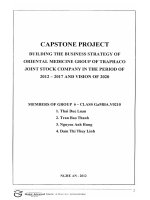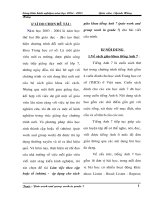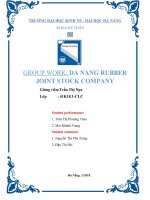group work ma1 group 7 ann arbor railroad company case
Bạn đang xem bản rút gọn của tài liệu. Xem và tải ngay bản đầy đủ của tài liệu tại đây (1.03 MB, 13 trang )
<span class="text_page_counter">Trang 1</span><div class="page_container" data-page="1">
<b> </b> H C VI N TÀI CHÍNH ỌỆ
<b> VI N ĐÀO T O QUỐỐC TẾỐ ỆẠ Institute of International Finance Education </b>
DUAL DEGREE PROGRAMME- DDP
<b> GROUP -WORK -MA1 </b>
<b>Group 7</b>
<b>Group members: 1, Hồ Tự Hồng – DDP0603123 2, Vương Thành Công – DDP0603125 3, Khúc Thành Lộc - DDP0603112 4, Vũ Minh Tường – DDP0601045 </b>
<b>Academic Year (Semester): 2023-2024 (Semester 1) Class Code: MA1.0604 </b>
<b>Mentor: ThS. Ngô Như Vinh </b>
</div><span class="text_page_counter">Trang 2</span><div class="page_container" data-page="2"><b>Ann Arbor Railroad Company case</b>
Ann Arbor Railroad (AAR) is a railroad company that is partly financed by the USDepartment of Transportation through its high-speed rail stimulus initiative. AARoperates a daily train service between Detroit, MI, and Chicago, IL. The Companyoperates two classes of passenger trains: slow-speed and high-speed. AAR built andcurrently maintains a roadbed and tracks between the two cities as well as stations in bothDetroit, MI, and Chicago, IL. The tracks and signaling equipment cost approximately $1million per mile to build and will be depreciated over thirty years.
The bulk of the Company’s station-related costs arise from the Detroit and Chicagostations. Costs for the intermediate stations, which are only used by the slow-speed trains,are largely paid for by the local municipalities.
AAR does not own any trains but leases them. Specifically, it leases 10 high-speed trains(locomotives plus carriages) from Siemens AG and 10 slow-speed trains (locomotivesplus carriages) from GE. Locomotives refer to the motorized entity pulling the carriages.Carriages carry passengers but are unable to move autonomously. The Company isresponsible for maintaining the trains. The high-speed trains are technologicallyadvanced and more costly than the slow-speed trains, which are technologically simplerand older. AAR employs the train engineers and the onboard service staff.
The Company has contracted with Gourmet Services Inc. to provide complimentary foodand drinks to high-speed passengers. The contract entails a fixed monthly payment of$700,000 plus $8 per passenger. Slow-speed train passengers receive no complimentaryitems; they can buy food and beverages from an independent catering company with noprofit or loss for AAR.
Projected cost and travel volume data appear in Tables 1 and 2. Please refer to these toanswer the following questions. The data are only approximate and have been modifiedto ease computations.
</div><span class="text_page_counter">Trang 3</span><div class="page_container" data-page="3"><b>Table 1: Ann Arbor Railroad — Projected cost for March 20X0. </b>
Head office-related (inDetroit station)
Administrative personnel,
marketing costs, IT costs <sup>$500,000 per month</sup>
Roadbed, track, andsignaling equipment-related
Depreciation of track &
signaling equipment <sup>$1,000,000 per month</sup>Interest payments $500,000 per monthMaintenance workers $5,000 per month
Repair materials <sup>$200 per slow-speed trip</sup>$400 per high-speed trip
Building costs (temperaturecontrol, leasing costs, etc.) andother costs (including cleaningservice, ticket, and baggagehandling personnel)
Detroit: $20,000 per monthChicago: $32,000 per month
All other stations combined:$7,000 per month
Leasing costs – slow-speed
train <sup>$100,000 per month per train</sup>Leasing costs – high-speed
train <sup>$500,000 per month per train</sup>Hauling costs (power and fuel) <sup>$5,000 per slow-speed trip</sup>
$8,000 per high-speed tripEngineers and onboard service
staff total <sup>$150,000 per month</sup>Onboard services Gourmet Services Inc. contract $700,000 per month
$8 per passenger
<b>Table 2: Ann Arbor Railroad — Projected business for March 20X0.</b>
VOLUME Slow-Speed High-Speed
</div><span class="text_page_counter">Trang 4</span><div class="page_container" data-page="4">Note: Passenger volumes and fares are averaged across trips. Trips and AverageTicket Price both refer to round trips.
</div><span class="text_page_counter">Trang 5</span><div class="page_container" data-page="5"><b>=8.43=10.83Other Fixed Costs ($)</b>
Head Office Related Cost 500,000Building Cost- Detroit 20,000Building Cost-Chicago 32,000Buliding Cost-Other
<b>Total Projected Cost for Month 20X0</b>
<b>Question 2. What is the projected profitability per passenger (revenues minus costs) for the</b>
high-speed and slow-speed services for March 20X0?
<b>Anna Arbor Railroad Statement of Profitability per passenger </b>
Revenue form Tickets (180*100,000)
Less: Fixed cost per passenger ( From Q1)
11.62 14.02
<b>Part 2. Management decisions</b>
<b>Question 3. Assume that you are the manager in charge of the high-speed service. On March</b>
</div><span class="text_page_counter">Trang 6</span><div class="page_container" data-page="6">a round trip from Detroit to Chicago on March 21st to conduct a market research study for theirfinal project. Specifically, the MBA students have arranged for undergraduates to participate inthe study, which is aimed at identifying factors that make train travel more attractive tocustomers. The MBA students are on a limited budget and propose to pay Ann Arbor Railroad$1,000 for the round trip for the 20 seats. Tickets sales for March 21st have been low, and, as oftoday, there are still over 100 seats available. Would you accept the students’ offer?
Reservations : 20 Price per seat : $ 1,000Total revenue from the offer : 20 seats x $ 1,000 = $ 20,000
<b> Cost of sale = ( $843,000 - $20,000 )/ $100,000 ( total passengers of high speed) = $82,3</b>
Profit per passenger = $97,7
- As per the Fact of Question, An MBA student offer 20 round trip revenue and ourcalculation shows that it will reduce the fixed cost burden because on 21st Marchpassenger is rate is very low. In my opinion, now accept the offer based on the abovecalculations
<b>Explaintion : </b>
Accept the pupil’s offer would net $ 4,000
Accord to calculations. However, ticket sales, seat availability, and consumer effect should be considered. Accept the offer could boost revenue and market research if the seats can be sold at higher prices, may be better to wait to accept the offer. Business strategy and long-term
</div><span class="text_page_counter">Trang 7</span><div class="page_container" data-page="7"><b>Question 4. Using the information from Table 2, what is the number of tickets that Ann Arbor</b>
Railroad must sell to break even in each service line? What is the volume of sales that AnnArbor Railroad must generate to break even overall?
For Break-even, we are only considering fixed costs which have been allocated to the service lines. We are ignoring other fixed costs.
Break even point for each service line:- <b>High-speed service:</b>
Fixed cost = $843,000
Contribution per passenger = $89,8 - $8 (Gourmet service) = $81,8Break even point = $843,000 / $81.80 = 10,305 tickets - <b>Slow-speed service:</b>
Fixed cost = $812,000
Contribution per passenger = $22,8
Break even point = $812,000/ $22.80 = 35,614 tickets Assuming the sale of mix remains unchanged:
Total fixed cost: $2,214,000
Weighted average contribution per passenger: $61,9
<b>Overall</b>: Break even point = $2,214,000 / $61.09 = 36,242 tickets
Question 5. Should Ann Arbor Railroad offer discounted tickets for the high-speed service on aregular basis if there are still seats available right before a train departs?
- Anna Arbor Railroad should consider offering discounted tickets for the high-speed service on the same terms offered to MBA students on a regular basis if there are still seats available right before a train departs. This strategy can help increase revenue and improve the utilization of the high-speed trains
- By offering discounted tickets, Ann Arbor Railroad can attract more customers who my not have considered taking the high-speed train due to the high price. This can also help more customers in the future. Additionally, by filling up seats that would otherwise remainempty, the company can maximize its revenue and improve the utilization of its resources.- However, Anna Arbor Railroad should be cautions about how it implements this strategy. Offering discounted tickets on a regular basis may lead to customers waiting until the last minute to purchase tickets, which can disrupt the company’s planning and create uncertainly. To mitigate this risk, the company should limit the availability of discounted tickets to a certain percentage of total seats, and make sure that the prices are high enough
</div><span class="text_page_counter">Trang 8</span><div class="page_container" data-page="8"><b>Question 6. Among the two cost configurations computed in question 2 and question 3, which</b>
one would you use as a reference to set the long-term price for the high-speed service?
Then compare two cost configurations, we can chosing the way of Question 3 for thelong-term price for the high-speed service because it brings to the higher profit perpassenger and helping the company can control the cost.
<b>Question 7. Under the High-Speed Intercity Passenger Rail (HSIR) program (sponsored by the</b>
US Department of Transportation), Ann Arbor Railroad has received a $5 million grant forcapital investments. The money will be used to upgrade the signaling system along the tracksand to install more efficient and safer switches. As a result, travel time and hauling costs for thehigh-speed service will be reduced. More specifically, the average hauling cost per trip for thehigh-speed service will be reduced to $6,500, while the average travel time will be 15 minshorter. Would you update the price per ticket, for the high-speed service, to reflect thereduction in the hauling costs?
<b>When the average hauling cost per trip for the high-speed service will be reduced to$6,500 will change in total projected cost </b>
</div><span class="text_page_counter">Trang 9</span><div class="page_container" data-page="9">Maintenance Workers Cost 3,000 2,000 5,000( on no of Tríp 300:200 )
Engineer & On board Staff Cost
<b>=10.83Other Fixed Costs ($)</b>
Head Office Related Cost 500,000Building Cost- Detroit 20,000Building Cost-Chicago 32,000Buliding Cost-Other stations 7,000
<b>Total Projected Cost for </b>
the projected profitability per passenger (revenues minus costs) for the high-speed andslow-speed services for March 20X0 when changed the hauling cost ( hight speed servicewill be reduced to $6,500 )
</div><span class="text_page_counter">Trang 10</span><div class="page_container" data-page="10"><b>Anna Arbor Railroad Statement of Profitability per passenger </b>
Revenue form Tickets ($180*100,000)
<b>=18,000,000</b> <sup>($50*75,000)</sup><b>=3,750,000<sup>21,750,000</sup></b>
Less : Variable cost (8,570,000) (2,040,000) 10,610,000
Less: Fixed cost per passenger ( From Q1)
11.62 14.02
The number of tickets sold to customers will change Break even point for each service line:
- <b>High-speed service after changed:</b>
</div><span class="text_page_counter">Trang 11</span><div class="page_container" data-page="11">Reducing the break-even point can help businesses achieve profits faster.
Would you update the price per ticket, for the high-speed service, to reflect the reduction inthe hauling costs?
- Yes, updating the price per ticket for the high-speed service to reflect the reduction inhauling costs is a common approach in many transportation and business models.- When there's a reduction in hauling costs due to improvements in infrastructure oroperational efficiencies, businesses often consider adjusting their pricing to reflect thesechanges. Lower costs may allow for increased profitability, improved competitiveness, orenhanced value proposition for customers.
<b>Part 3. Design of management accounting systems</b>
<b>Question 8. Question 2 asked about the projected profitability per passenger. Why do we need</b>
projected cost and revenue figures? Why do we not wait until the end of the month/year tocompute actual costs and revenues?
<b>A, Why do we need projected cost and revenue figures?</b>
<b>1. Planning and Decision Making: Forecasts offer a glimpse into the future and aid in</b>
planning. They provide a basis for making strategic decisions, setting goals, allocatingresources, and managing risks. Companies use forecasts to anticipate market trends,consumer demands, and operational needs. For instance, a retail company might forecastdemand for certain products to ensure sufficient inventory is available during peakseasons.
<b>2. Proactive Strategy: Forecasts enable companies to adopt a proactive approach rather</b>
than a reactive one. By foreseeing potential challenges or opportunities, they can prepareadequately. For example, an energy company might use weather forecasts to anticipatedemand, enabling them to adjust their energy production accordingly.
<b>3. Risk Management: Forecasts help in risk assessment and mitigation. Companies can</b>
anticipate financial risks, market fluctuations, and other potential challenges, allowingthem to make informed decisions. Insurance companies, for instance, heavily rely onforecasts to calculate potential risks and set premiums accordingly.
<b>4. Resource Allocation: Using forecasts assists in better resource allocation. Companies</b>
can efficiently allocate funds, manpower, and time based on expected needs anddemands. For instance, a construction company might forecast material costs and laboravailability for upcoming projects, allowing them to manage resources more effectively.
</div><span class="text_page_counter">Trang 12</span><div class="page_container" data-page="12">investment. Companies can use predictions to identify emerging trends and areas forgrowth. For instance, technology companies use forecasts to invest in new technologiesor to anticipate market trends for future products.
<b>6. Long-Term Planning: Forecasts help in long-term planning and strategy development.</b>
Companies can set long-term goals and create strategies that align with futureexpectations. For instance, in the pharmaceutical industry, companies rely on forecasts toplan long-term research and development efforts for new drugs or treatments.
<b>7. Uncertainty Mitigation: While actual (ex-post) data is valuable, it's backward-looking</b>
and might not encompass changes or uncertainties in the future. Forecasts help in dealingwith uncertainties. For example, financial institutions use economic forecasts to makeinvestment decisions in volatile markets.
<b> B, Why do we not wait until the end of the month/year to compute actual costs andrevenues? </b>
Waiting until the end of the month or year to calculate actual costs and revenues can causemany limitations. Real-time data is essential for flexible decisions, strategic adjustments andhelps businesses adapt to market changes effectively. Waiting until the end of the term candelay decisions, miss opportunities, and fail to promptly address emerging issues. Continuousdata provides better financial control, early detection of problems and effective operationaladjustments, while end-of-period data is only suitable for long-term reporting.
<b>Question 9. Besides the potential inaccuracy of cost and revenue projections, what problems</b>
do you foresee when managers in an organization use them to base their decisions?
<b>1. Uncertainty: Predictions are based on current and past information, but the future is always</b>
uncertain. Unexpected factors can change both costs and income.
<b>2. Process risk: Too much prediction can lead to risky decision making without enough</b>
consideration of risk mitigation options.
<b>3. Dependence on data: Quality is expected to depend greatly on the quality of input data. If</b>
the data is inaccurate or incomplete, the prediction results will also be affected.
<b>4. Time and resources: The work of collecting and analyzing data to create predictions can be</b>
time- and resource-intensive.
<b>5. Psychology: May try to “achieve” expected numbers, even if this is not what is best for the</b>
organization.
</div>








